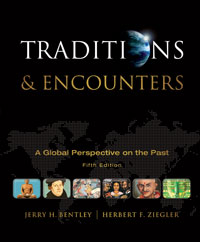Traditions and Encounters, AP Edition (Bentley), 5th EditionChapter 31:
Societies at CrossroadsOverviewThe dramatic economic expansion of western Europe and the United States in the nineteenth century was not matched by the older empires of Asia. The Ottoman empire, the Qing dynasty, the Russian empire, and Tokugawa shogunate had all been vibrant and dynamic cultures at one time, but by 1800 had become isolated and backward. By 1900, all four had been challenged and changed profoundly. Common dimensions of those changes include the following: - Conservative autocratic regimes. None of the regimes discussed here shared in the liberal ideals of the Enlightenment or the revolutionary era. Rulers were absolute; individuals had few rights; and dissent was viewed as dangerous.
- Military unpreparedness. Since these regimes failed to modernize, they found themselves outgunned by the western powers. Often this realization followed a humiliating defeat—the loss of Egypt for the Ottomans, the Opium War for China, the Crimean War for Russia, and the unequal treaty forced on Japan by the United States. For most regimes, this realization led to a radical restructuring of the military.
- Weak economies. All four regimes lacked the basic elements for industrialization: capital, free workers, and infrastructure. China and Japan had been closed economies and had little contact with the outside world. The Ottoman and Russian empires had been agricultural societies with large unskilled peasant populations.
- Imperial pressures. All four had to fight off the imperialistic encroachments of the industrializing powers. The Qing dynasty was the least successful and, by the end of the century, had lost control of its economy and much of its territorial sovereignty. Japan was most successful in competing economically and militarily with the west.
- Reform from the top down. Change, when it came, was entirely at the discretion of the rulers. Japanese reformers, for example, perceived that a written constitution would give credibility to their new state, so that the emperor “gave” a constitution to the people that retained all power for the emperor. The Russian tsar granted, and then rescinded, an elected legislature after the revolution of 1905.
 | 
















